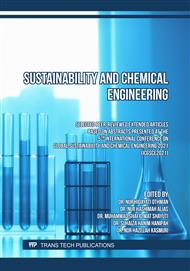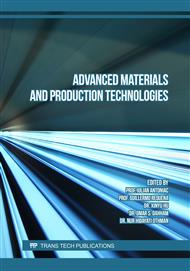p.39
p.49
p.57
p.67
p.87
p.93
p.103
p.115
p.129
Ring Opening Polymerization in Polylactic Acid Production Using Different Catalyst
Abstract:
Polylactic acid is a biodegradable polymer with wide range of applications in food packaging and medical industries. Polylactic acid is commonly derived from lactic acid which is made from sugar and starch via bacterial fermentation. Whereas the production of polylactic acid via ring opening polymerization uses lactide as its precursor. This method undergoes reaction with the presence of catalyst. In this research, polylactic acid is produced via ring opening polymerization using different catalyst. However, very few studies conducted on how the catalyst effects the molecular structure of the PLA produced. The main objective is to study the effect of using stannous octoate (SnOct2) and anhydrous lithium chloride (LiCl) as catalyst in producing PLA. Lactide is reacted with SnOct2 and LiCl at 130°C at different ratio of lactide to catalyst (Lac/Cat) of 25/1, 50/1 and 100/1 by weight. The resulting PLA is characterized using Fourier Transform Infrared Spectroscopy (FTIR) to analyse the molecular structure and UV-Visible Spectrometer (UV-VIS) to measure the concentration of the PLA obtained. The ratio of Lac/Cat shows significant difference on the PLA with SnOct2 as the catalyst but shows no significant difference on the PLA with LiCl as the catalyst. Nevertheless, LiCl can still be used as the catalyst in producing PLA which has been proved by the presence of certain peaks on the FTIR spectrum. However, further investigation needs to be carried out to understand the ROP mechanism when using LiCl as the catalyst.
Info:
Periodical:
Pages:
87-92
Citation:
Online since:
December 2022
Authors:
Keywords:
Price:
Сopyright:
© 2022 Trans Tech Publications Ltd. All Rights Reserved
Share:
Citation:



